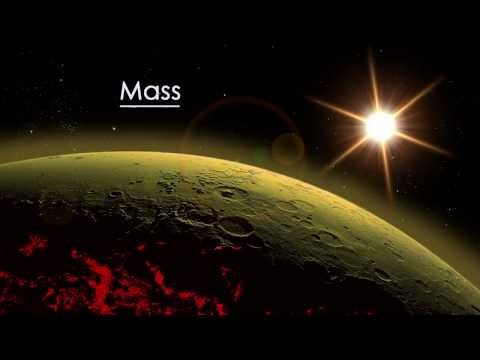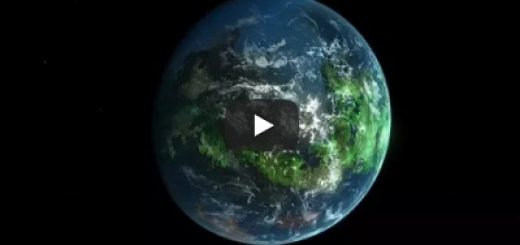50 Surprising Facts About Space You Didn’t Know
As has been famously said, space is the final
frontier. The greatest of unknowns, space is far vaster
than we can comprehend, and filled with phenomenonwe barely understand. While we’ve been watching the heavens in awe
for millenia, space exploration and discoveryonly began in earnest in the mid 20th century. Yet even what are no doubt our primitive findings
still point at a universe more incrediblethan we ever thought. Hello and welcome to another episode of The
Infographics Show- today we’re taking a lookat 50 incredible facts about space!50. Until 1923 scientists thought that the entire
universe was just our milky way- until astronomerEdwin Hubble discovered that the astronomical
feature known as Andromeda, a fuzzy spot inthe night sky, was actually an entire other
galaxy!Overnight the size of the universe was effectively
doubled! 49. Hubble made his discovery from the Hooker
telescope, built atop a mountain in California-it was the first mountain top telescope in
the world and at the time, an incredible featof engineering. 48. To measure the distance between galaxies in
space, astronomers use Cepheids, or starsthat periodically dim and brighten. Henrietta Leavitt discovered that by monitoring
the time it took these stars to dim and brightenyou could calculate how far away they were. 47. Leavitt’s discovery of how to calculate distance
based on the cycling of Cepheid stars allowedHubble to prove that Andromeda was located
outside the Milky Way, and was thus its owngalaxy. 46. Hubble scanned Andromeda for nights on end
looking for Cepheid stars, until finally discoveringone in October 1923. After monitoring it for a week, he used Leavitt’s
formula and determined it was indeed locatedoutside the Milky Way. 45. In 2011 the Hubble Space Telescope captured
a picture of that star, called “VariableNumber One”- or V1. It has been called “the most important star
in the history of cosmology. ”44. Of all the planets in our solar system, only
mercury and venus don’t have moons. 43. The hottest planet in our solar system is
not Mercury as most would assume, but Venus. Due to runaway global warming, Venus’ temperature
is an incredible 863 degrees Fahrenheit . 42. Not only is Venus’ atmosphere blazing hot,
but it also has an atmospheric pressure 92times greater than the Earth’s- that would
crush you flat as a soda can if you walkedon its surface!41. In 1966 the Soviet Union’s Venera 3 was the
first man-made craft to land on Venus. Unfortunately its communications system had
failed long before reaching Venus and it wasunable to relay back any data. 40. Although it crash-landed and didn’t send any
data back home, Venera 3 is the first human-madeobject to impact another planet’s surface. 39. On the 18thof October 1967, Venera 4 became
the first spacecraft to measure the atmosphereof another planet. The soviets initially claimed the craft reached
the surface intact, but when the AmericanMariner 5 spacecraft flew by Venus the very
next day, it measured a surface pressure of75-100 atmospheres, well out of the range
of Venera’s 4 25 atmosphere hull strength. The claim by the Soviet Union was quickly
redacted. 38. Venus’s atmosphere is so dense, that parachutes
are only necessary to slow down. The Soviet Union’s Venera 9 released its parachutes
at an atmospheric height of 31 miles and landed at a speed of only 15 mph . It was also the first space craft to transmit
photos from another planet!37. Our solar system is about 4. 6 billion years
old, and scientists believe it will last another5 billion years before our sun turns into
a red giant. 36. The tallest mountain known to man is Olympus
Mons, an extinct volcano on Mars with a peak15 miles high. It is nearly 3 times larger than Mount Everest. 35. A light year is the distance light travels
in one year, or 5. 88 trillion miles . 34. The width of our Milky Way galaxy according
to NASA is about 1,000,000,000,000,000,000kilometers, or 621371192237333888 miles- or
in astronomical terms: 100,000 light years. 33. Because most stars are so far away, when you
look up into the night sky you are not seeingthem as they currently are, but as they were
thousands of years ago- that’s how long theirlight takes to reach us!32. Our sun is 300,000 times larger than the earth,
but in the universe it’s a light weight. 31. The largest star in the known universe is
VY Canis Majoris- it is 1,400 times largerthan our own sun!If you stuck it in our solar system it would
extend all the way past Jupiter. 30. Red Giants are really old stars that form
when stars 10 times the mass of our sun runsout of hydrogen in its core. As it collapses the hydrogen in the outer
shells begin the process of fusion, and theentire star begins fusing hydrogen all at
once. They will burn through all their fuel in just
a few million years- unlike the billions ittakes our sun- and shine 100,000 times brighter
than our sun!29. These stars often explode as a Supernova-
the most powerful explosion in the universe. 28. The original universe consisted solely of
hydrogen and helium- every other element onthe periodic table and every single thing
you see around you today was formed in theheart of exploding stars. 27. That’s because when a star goes supernova
it releases huge amounts of energy and neutrons,which produces heavier elements. The carbon in your body and the gold in the
jewelry you wear were all made from explodingstars!26. Only hydrogen and helium were formed from
the Big Bang- next time you suck down heliumfrom a party balloon you are sucking down
a gas that probably formed just 3 minutesafter the Big Bang!25. Red Giant Betelgeuse, 1000 times larger than
our sun, is a cosmic neighbor and expectedto go supernova in the next 1,000 years!24. Some scientists theorize that life is only
possible in the outer edges of a galaxy, wherelarge stars are rare and thus supernovas don’t
routinely sterilize worlds of life. 23. We ourselves are between two arms of the milky
way, and in a relatively rural part of thegalaxy. 22. Extending well past the orbit of Pluto is
a massive sphere of icy objects known as theOort Cloud. These are remnants from the formation of the
solar system, held in place by the weak gravityof the very distant sun. 21. Every few million years as we orbit the center
of the Milky Way we enter a region of spacefull of cosmic debris. Some scientists theorize that this debris
may disturb the fragile orbits of objectsin the Oort Cloud and send them hurtling into
the solar system. The timing of our entry into this region of
the Milky Way coincides with several massextinction events here on Earth. 20. Panspermia is the theory that life is transmitted
like a virus from planet to planet by asteroidand comet impacts. 19. A meteorite discovered in Antarctica was found
to originate from Mars, and after carefulexamination some scientists believe it shows
fossilized evidence of microscopic organisms-giving serious credibility to the Panspermia
theory. We might all actually be martians!18. It’s thought that this meteorite was launched
into space from Mars when a massive asteroidstruck the planet, sending debris hurtling
out of the atmosphere. In time its orbit intersected with the Earth
and may have brought its martian hitchhikerswith it!17. In 2008 an ESA mission sent tardigrades- tiny
microscopic organisms- into space. After ten days of exposure to the vacuum of
space, ultraviolet radiation from the sun,and cosmic rays, they were returned to Earth
still alive!16. Before the tardigrades, only some lichen and
bacteria were known to survive exposure tospace- meaning Panspermia may be a valid theory
for the origin of life on earth. 15. Because there is no atmosphere on the moon,
the footprints and tire prints left on theMoon by American astronauts will never disappear-
unless an asteroid impact wipes them out. 14. Not only does Jupiter have the most moons
in our solar system- with 79- but as of rightnow it has the most moons of any known planet
in our galaxy. 13. Many scientists think that without Jupiter
life on earth would be impossible. That’s because the giant of our solar system
exerts such a strong gravity that it pullsin many comets and asteroids that might have
impacted on Earth. Jupiter is like our personal bodyguard!12. Once thought rare outside of the Earth, water
has been found practically everywhere in thesolar system- even on Mercury where scientists
never dreamed it would be possible!In 2011 NASA’s Messenger probe discovered
water ice in craters on Mercury’s north pole. That’s despite a surface temperature of 800
degrees Fahrenheit onthe day side. 11. Not only does the earth rotate as it orbits
the sun, but the sun itself also rotates ata rate of once every 25-35 days. 10. Earth is the only Solar System planet not
named after a god. 9. Pluto is smaller in diameter than the United
States. 8. The first theory positing the existence of
black holes was from an English clergymannamed John Michell in November 1784. He even correctly noted that these features
would not be visible to the naked eye, butthat they could be detected by their gravitational
effects on other bodies. 7. Despite proving through General Relativity
that black holes could form, Einstein himselfdid not believe they could form in the natural
world. It wouldn’t be until 1972 that Cygnus X-1
became the first observed black hole, takingthem from the realm of theory to the realm
of reality. 6. In 2002 astronomers presented evidence that
a supermassive black hole lurks at the centerof our Milky Way. 5. In 2012 Suvi Gezari and his team published
the first visual evidence of a black hole. Using the Pan-STARRS 1 telescope in Hawaii,
they photographed a supermassive black hole2. 7 million light years away swallowing a
red giant. 4. In 2015 gravity waves from the merging of
a pair of black holes into one were detected. The violence of their merging created a ripple
through space-time that was detectable hereon Earth millions of light years away!3. Not only did general relativity predict that
black holes were possible, but it also predictedthat white holes could also be possible!The polar opposite of a black hole, a white
hole is a region of space-time where mattercannot enter. 2. A growing theory suggests that white holes
are the opposite ends of black holes, andthat our own Big Bang was a supermassive white
hole that existed for fractions of a second. 1. Afraid that returning astronauts might be
carrying unknown and deadly lunar germs, theApollo astronauts were quarantined immediately
after their arrival on earth.













